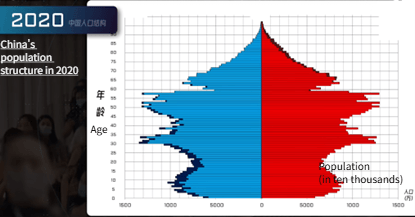
Based on the data shown in this picture, between 2016 and 2024, the permanent population aged 60 and above increased from 231 million to 310 million, representing an approximately 79 million increase over 8 years. Does this picture convey the message only about the increasing number of elderly people in China?

When we combine the following image, we will find that this is not just a problem of increasing elderly population, but also a problem of social aging. According to the population structure chart of China in 2020, we find that the number of people from 30 to 60 years is far greater than that of people from 0 to 30 years.
The aging population will bring many social problems, such as elderly care issues. China uses a pay-as-you-go system, which means using the social security contributions made by young people to provide
pensions to the elderly. From the second picture, it can be seen that the number of people in the age group of 30 to 60 is much larger than that of people over 60 years old. However, when the people in this group of 30 to 60 years old get old, they will have to rely on the group of 0 to 30 years old to support them. But you can read books on the way, and the number of people in the 0-30 age group is much lower than those in the 30-60 age group.
Apart from the issue of pension, behind the 310 million elderly population is the contradiction between the supply and demand of elderly care resources. Taking elderly care beds as an example, by the end of 2023, more than 87000 pairs of elderly care service institutions and medical and health institutions had signed cooperation contracts nationwide. There were 7881 medical and health institution qualifications and registered elderly care institutions, with a total of about 2 million beds. However, this
number reflects the problem that the bed gap is still significant. In addition, the elderly are a high-risk group for chronic diseases and frequent illnesses. The elderly disease diagnosis and treatment capabilities of grassroots medical institutions, as well as the adaptability of long-term care insurance systems, need to iterate with the acceleration of aging; otherwise, it will exacerbate the risk of medical resource depletion.
Consequently, the first chart is not only a growth curve of population numbers, but also a stress test table of the social system: it connects the transformation needs of multiple fields such as elderly care, healthcare, and economy, revealing both the challenges brought by accelerated aging and opportunities such as the silver economy and the exploration of the social value of the elderly.
Reference:
http://www.npc.gov.cn/c2/c30834/202412/t20241202_441336.html

